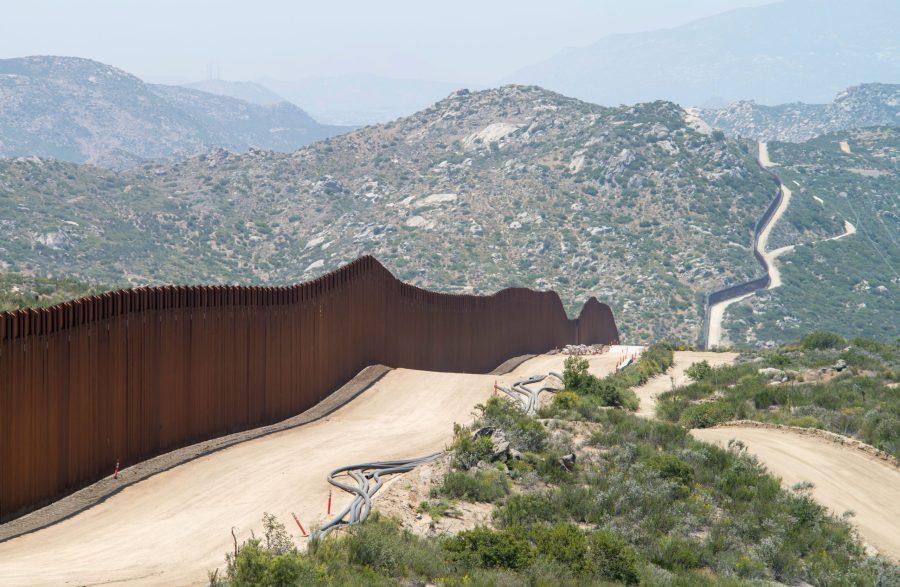The upgrades to the border placed health risk for immigrants and those who need access to an urgent care center in San Diego. The continuing focus on deterrents to crossing allow for more dangers placed on immigrants.
The conversation around immigration in the United States focuses mainly on providing pathways for undocumented immigrants already in the country and the treatment of families crossing the US-Mexico border.
During his presidency, Donald Trump placed his attention on amplifying border security and attempting to build a “wall” so less people could cross over (without much discussion on how to improve the legal crossing process).
Throughout Donald Trump’s presidency, immigration and border reform were a clear staple of his platform. Trump’s goal was to limit the amount of illegal immigrants which cross over each year along with providing solutions for DACA (Deferred Action for Childhood Arrivals) recipients.
Much controversy surrounded “the wall,” a completely new border which was supposedly meant to surround the northern part of Mexico. Trump ultimately did not receive the funding needed for an entire reconstruction, but the border was upgraded in order to deter more people from crossing.
Trump constructed a “secondary wall,” providing an additional layer of closure that was made completely of steel. Additionally, the border expansion included more cameras and surveillance systems.
The height of “the wall” lies between 18-30 feet in the air, featuring metal plates on the top. The goal of the wall was centered around limiting illegal immigration, but a recent study published through UCSD Health reveals devasting results from the expansion.
Amy Liepert, medical director of acute care surgery at UC San Diego Health, led a study about the safety of the wall and the overall injuries caused by the height increase and new materials.
In the study, the findings indicate a lack of decrease in the amount of people who cross the border.
“The height increase of the border wall along the San Ysidro and El Centro sectors was touted as making the barrier ‘unclimbable,’ but that has not stopped people from attempting to do so with consequential results,” Liepert told UCSD Health.
1.6 million people attempted to cross the border last year, a record breaking figure. The number of people crossing did drop a few years prior, but the pandemic and other factors led to the figures all jumping up.
While the attempts to cross the border rose, the number of individuals who were successful dropped by a significant amount. It appears as if the border upgrades has increased the difficulty for those attempting to cross.
Liepert’s study concluded that along with increasing difficulty, the risk of injury has also increased.
“Raising the US border wall to 30 ft is associated with increased deaths, increased ISS, and increased health care costs,” Liepert said. “It increased the burden of complex injured patients at a Level 1 trauma center already dealing with a trauma surge and respiratory surge during the COVID-19 pandemic. Most of these patients had significant brain and facial injuries or complex fractures of the extremities or spine, with many requiring intensive care and staged operative reconstructions.”
In other words, the risk of falling from such heights, especially with plenty of steel metal around, creates plenty of room for danger and injuries.
The height now requires a ladder to go over, adding more risk than simply climbing a fence. People, in a panic from the incoming border patrol, can move the ladder or lose balance.
“We have different types of border barriers in the 264 miles of border between El Paso, New Mexico and Juárez,” Liepert said to UCSD. “Transnational criminal organizations continue to encourage people to climb that barrier. They use ladders to climb to the top and then they pull the ladder off, leaving the person stuck at the top of that barrier to figure out how they are going to descend.”
The injuries are then the problem of medical centers south of the border, including UC San Diego Health.
“Additional capacity and associated costs were not accounted for in the federally appropriated funds to reinforce and heighten the border barrier system,” Liepert said. “Hospital costs for border wall-injured immigrants at UC San Diego Health alone are estimated to be approximately $13 million between 2019 and 2021.”
While these local medical centers face an increase in people seeking medical attention, most of the immigrants taken to these centers lack health insurance. This limits their ability to receive adequate medical treatment and properly rehabilitate their injuries.
557 people died crossing the border from October 2020 to September 2021, with the figures all remaining undercounts of the actual figures. Contributing to the death figure are the rising trafficking of migrants and the gang activity around the border.
Still, a trend of more trauma resulting from border crossing is hard to ignore. The San Diego health system is shouldering a lot of the burden while immigrants are left to face another risk of crossing the border.
“The recent increase in water levels has led to numerous rescues and has already taken the lives of several migrants this year,” Border Patrol officer Gloria Chavez told El Paso Times. “The currents in the canal are very strong and pose a threat to even the most experienced swimmer.”
As migrants continue to face more challenges, the future of immigration reform remains unclear. More resources towards medical facilities are needed to deal with the increasing number of patients, according to Liepert. She also recommends further examination of how the border can become safer for those crossing, especially with the high volume trying to come across.
Ideas of modernizing border security are being bounced around. Earlier this year, the U.S Customs and Border Protection released their idea of Robot Dogs patrolling the surrounding area around the border.
With all-terrain legs and camera sensors, the dog is able to identify movement and people crossing over through all points of the day and night. The dog receives assistance from Military grade technology, providing a way to develop even more deterrents.
Less human interaction among immigrants and border patrol allows for a potential room for error, but the trend remains of a focus on border control instead of its safety. Robot Dogs could bring a time of peace and less violence, but the underlying issue of the border’s new size remains unsolved.
Photo by Greg Bulla on Unsplash.













